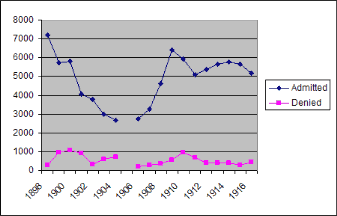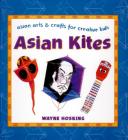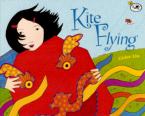|
The AACP Newsletter Asian American Curriculum Project, Inc. - Books for All Ages |
|||
|
|
|
|||||||||||
|
by Leonard D. Chan |
|||||||||||||||||||||||||||||||||||||||||||||||||||||||||||||
Guess the date and origin of, and the group that fits the underlines in the following passage - When I started my research for this month's articles, I had ever intent of writing a piece on the San Francisco 1906 Earthquake and Fire. Most of what I read was already being covered in the news, in special documentaries, and in various other media on the subject. There is a lot of material that you can find on the Earthquake. Anybody with some historical curiosity can spend much time engrossed in all the interesting facets of this major event. I will highlight just a few issues, its connection to today's news, and list some resources for your further research. The issues with the Earthquake that seem relevant and relating to today's news are issues of immigration and discrimination. With the debates over immigration law in congress and the stories of the post Katrina hurricane effect on the racially marginalized in New Orleans, anyone that has done some research on the San Francisco Earthquake will see a connection between these topics. My revelation to this connection started when I began to research the subject of Chinese to US immigration following the Earthquake. Many books and media stories on the Earthquake have some mention of the burning of San Francisco City Hall records and the significance it had on the Chinese American community in America. The story goes that when the records were destroyed, Chinese used the opportunity to claim that they were born in San Francisco and were thus United States citizens when they were really not. At that time Chinese were not allowed to become citizens through the naturalization process, so faking ones birth records in this way was the only recourse for China born Chinese to gain US citizenship. Because of the restrictive Chinese immigration laws, the only Chinese that were being allowed into the United States were merchants (business people), students, teachers, returning laborers that had special return permits, citizens, and spouses and children of citizens. The burning of the birth records thus supposedly resulted in a flood of new immigrants claiming to be spouses and children of Chinese citizens. To my amazement, one of my contacts at the National Archives told me that he thought this |
bit of history was being overstated and that he saw no evidence to support a massive influx of Chinese after the Earthquake. He suggested that I look at the statistical data found in the annual reports of the Commissioner-General of Immigration to the Secretary of Commerce and Labor written in the years before and after the Earthquake. In my limited research, here's what I was able to find (see table below). Although the number of Chinese that were being admitted into the United States increased after 1906, the level was still below the figure for 1898. In the 10 years following the earthquake there was no massive increase in the number of Chinese admitted into the United States. From the years 1907 to 1916 the total admitted was 52,994. When compared to the millions of Europeans that were allowed to immigrate to the United States during this same period, this figure was a drop in the bucket. As you may have guessed by now, the quote at the beginning of this article was from the 1913 report of the Commissioner-General of Immigration to the Secretary of Commerce and Labor on the effectiveness of the Chinese Exclusion Law. Along with the plethora of data in each annual report, the Commissioner-Generals included summary text on what they saw in the data. Interesting enough, the 1903 summary text was basically touting the effectiveness of the exclusion laws while the 1913 report saw grave short comings with it. The extra few thousand Chinese immigrants each year basically fed the suspicions that Chinese were cheating the exclusion laws. Like today's immigration debates, many people in the late 1800s and early 1900s were quite disturbed by what would happen if undesirables were allowed to freely come and become legal residents and citizens. And as a result the first immigration laws were written to prevent certain groups like the Chinese from coming. The passage from the 1913 report was just a reminder of how, in over 100 years, little has changed except for which group is considered the law breakers and undesirables. Upon reading all the many stories on the 1906 Earthquake and Katrina Hurricane, one could see similarities between the two. Like New Orleans the poor ethnic communities were particularly hit hard. Chinatown and the various Japanese communities in the city were essentially decimated and little care was given to rescue efforts or even the counting of the dead. In the aftermath of the Earthquake, ethnic minorities like the Chinese were segregated and given poor locations for temporary encampments. Some city leaders seriously considered permanently moving all Chinese out of San Francisco and much thought and negotiating went into the consideration of where Chinatown should be rebuilt. In the end Chinatown was rebuilt in it original location mainly for economic reasons rather than a desire to have the Chinese back. |
||||||||||||||||||||||||||||||||||||||||||||||||||||||||||||
Chinese Immigration Data
|
 |
||||||||||||||||||||||||||||||||||||||||||||||||||||||||||||
|
|
|
Some Reading Suggestions
|
Website |
The following books are discounted for subscribers to our newsletter. The discounts on these books end May 5, 2006. | |

|
The Earth Dragon Awakes
By Laurence Yep |

|
San Francisco's
By the Japantown Task Force, Inc. |

|
EarthquakeBy Milly LeeIllustrated by Yangsook Choi 2006, 29 pages, Paperback. A young Chinese American girl tells the story of surviving the 1906 San Francisco Earthquake and Fire. This timely reissuing, in paperback form, of Milly Lee's story book, will help introduce young readers to a harrowing chapter in American history.
View Additional Information
|

|
Asian Kites
By Wayne Hosking |

|
Kite FlyingBy Grace Lin2002, 24 pages, Paperback. Kite Flying is a delightful little story of how a family works together to build and fly a dragon kite. The best part is the short text in the back, which gives some interesting background on the Chinese kite flying traditions.
View Additional Information
|
Copyright © 2006 by Asian American Curriculum Project, Inc. (a non-profit organization since 1970)
Visit our website at AsianAmericanBooks.com
To unsubscribe simply reply to this email and type "REMOVE" in the subject line.